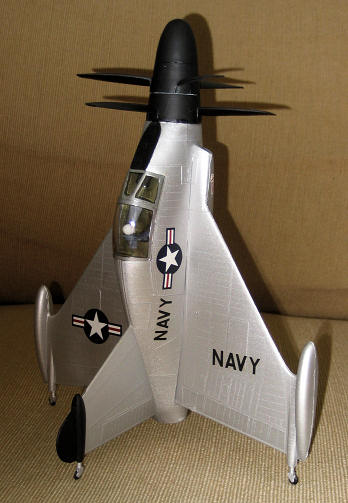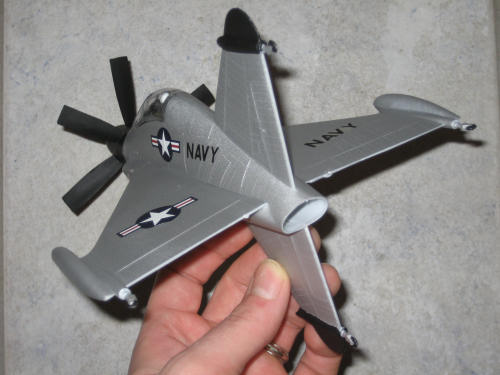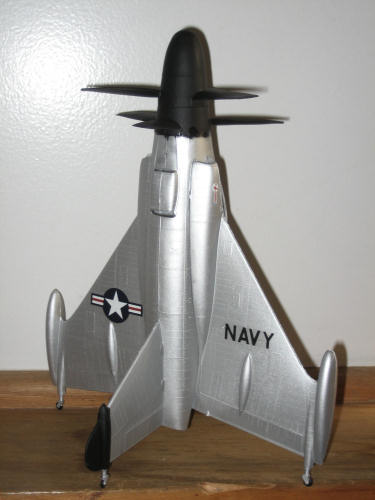Lindberg 1/48 XFY-1 'Pogo'
|
KIT: |
Lindberg 1/48 XFY-1 'Pogo' |
|
KIT #: |
? |
|
PRICE: |
$ |
|
DECALS: |
options |
|
REVIEWER: |
Joe Palmersheim |
|
NOTES: |
Re-release |

Taken from Wikipedia entry on subject: “After World War
II, the brewing conflict between the United States and the Soviet Union
prompted top United States Army and Navy to study VTOL operations. In May
1951, Lockheed and Convair were awarded contracts in the attempt to design,
construct, and test two experimental VTOL fighters that would be suitable for
use by the Armed forces. Although contract stipulations stated that each
manufacturer have two fighters, each was only able to construct one, with
Lockheed producing the XFV, and Convair producing the XFY, nicknamed the
"Pogo".
On 19 April 1954, a Convair engineering test pilot and
Marine reserve, Lieutenant Colonel James F. "Skeets" Coleman, made the first
tethered flight in the Pogo. The XFY-1 was like no other propeller driven
aircraft before it. No previous aircraft with a similar weight, engine power,
or size had ever attempted to take off and land vertically. For the safety of
both the craft and its pilot, the first test consisted of the propeller hub
cover being removed and replaced with safety tether lines for a case in which
the Coleman would lose control of the craft and would need to be tethered to
prevent the craft falling to the groun d. On the other end of the tether was
another engineer, Bob McGreary. If Coleman ever lost control, McGreary
controlled the winch, which could be turned to raise the tethers to prevent
the craft from plummeting to the ground. For further safety preventions, four
security cables were fastened to each wing in case control was lost in any
axis.
d. On the other end of the tether was
another engineer, Bob McGreary. If Coleman ever lost control, McGreary
controlled the winch, which could be turned to raise the tethers to prevent
the craft from plummeting to the ground. For further safety preventions, four
security cables were fastened to each wing in case control was lost in any
axis.
Throughout the next few weeks, Coleman logged almost 60
hours in test flights in the Pogo, and by August, the test was moved to
outdoor conditions. On 1 August 1954, Coleman logged two outdoor test flights,
the second flying 150 feet into the air, and shortly after he flew 70
takeoff-landing drills at the Naval Auxiliary Air Station in Brown Field,
California. The first conversion to horizontal flight took place on 2 November
1954. But upon later flights with longer durations, flaws in the design were
found. Due to the Pogo's lightweight design, and the lack of spoilers and air
brakes, the aircraft lacked the ability to slow down and stop efficiently
after moving at high speeds. Landing was also a problem, as the pilot had to
look back behind himself during a landing to properly stabilize the craft. Due
to these problems, the XFY Project was put on hiatus.
Although a test flight was made on 19 May 1955, it again
ended with failure, and on 1 August 1955, the project formally concluded. The
last flight of the Pogo took place in November 1956."
 Imagine my surprise on an idle Saturday when I saw my local hobby shop shelves
filled with Lindberg kits I hadn’t seen since I was a child. Some people don’t
like old kits from the 50s and 60s because of the lack of detail and realism;
they, of course, have a point. I, however, have a soft spot for these kits
simply because they aren’t at all pretentious and can be put together over the
course of a weekend. This 1/48 Lindberg Pogo kit was no exception. Once I laid
eyes on it, I knew I had to have it.
Imagine my surprise on an idle Saturday when I saw my local hobby shop shelves
filled with Lindberg kits I hadn’t seen since I was a child. Some people don’t
like old kits from the 50s and 60s because of the lack of detail and realism;
they, of course, have a point. I, however, have a soft spot for these kits
simply because they aren’t at all pretentious and can be put together over the
course of a weekend. This 1/48 Lindberg Pogo kit was no exception. Once I laid
eyes on it, I knew I had to have it.
Upon opening the box, the first thing one notices is
that everything in the kit is molded in white plastic. There is a fair amount
of flash on the sprues, which makes sense because the molds for this model
date back nearly 20 years before I was born. There were a few sprues
comprising less than 30 parts for this particular kit. A decal sheet was
contained with this kit.
As this is a vintage Lindberg kit, construction didn’t take too long. Once
neat feature of this kit is the use of two gears between the massive rotors to
allow them to counter-rotate just like on the real Pogo. Use plenty of oil on
these, as they te nd to grind. Mine don’t work perfectly, but they turn enough
for the layman to get the idea of how they were supposed to work on real life.
The prop was the hardest part of construction. The rest of the kit was utter
simplicity. I had the body of the plane together within 15 minutes, and set it
aside to dry. The “cockpit” of this particular craft consists of 1.) A vaguely
humanoid looking pilot, and 2.) His seat. I held on to these for later
painting. This kit also contains a boarding ladder, which was actually the
most difficult part of construction due to the careful cutting one needed to
do to get the thing pieces loose from the sprue.
nd to grind. Mine don’t work perfectly, but they turn enough
for the layman to get the idea of how they were supposed to work on real life.
The prop was the hardest part of construction. The rest of the kit was utter
simplicity. I had the body of the plane together within 15 minutes, and set it
aside to dry. The “cockpit” of this particular craft consists of 1.) A vaguely
humanoid looking pilot, and 2.) His seat. I held on to these for later
painting. This kit also contains a boarding ladder, which was actually the
most difficult part of construction due to the careful cutting one needed to
do to get the thing pieces loose from the sprue.
The painting for this kit was really simple. As this was more of a toy than
anything else, I used some Krylon silver spray-paint I found in the basement.
It turned out looking like metal, which was good enough for me. I painted two
wingtips black, as well as the massive prop, which was painted before being
attached to the fuselage. I painted the pilot olive drab, with black boots, a
tan face and white helmet. As there wasn’t much detail to be found on his
figure, I kept it simple. His chair was painted neutral grey.
 The decals were interesting, as the decals on the
instructions and those that actually came with the kid were half different.
The insignia were there, but several other maintenance markings on the
instructions were conspicuously absent from the decal sheet. For example,
there was only one (of two?) tail serials on the sheet. As this was a simply
prototype craft, I didn’t mind the simplicity.
The decals were interesting, as the decals on the
instructions and those that actually came with the kid were half different.
The insignia were there, but several other maintenance markings on the
instructions were conspicuously absent from the decal sheet. For example,
there was only one (of two?) tail serials on the sheet. As this was a simply
prototype craft, I didn’t mind the simplicity.
For reference, I looked on Wikipedia and YouTube for
pictures and footage of the actual craft. There was a really interesting video
I found on YouTube where a guy took a “flight” in a simulator for this craft,
and the performance is pretty remarkable. It also shows how dangerous this
thing would have been to land. Simply amazing. My mind only wonders what my
childhood imagination would have done with an aircraft like this.
This esoteric kit was a complete joy, simply because it
boils modeling down to what it used to be: an afternoon of fun with a semi-toy
for a reward. This particular craft is one of my new favorites. With a
5,000-plus horsepower turboprop on such a small airframe, I can only wonder
what this plane would have been like with open skies and a full throttle…
 Highly recommended!
Highly recommended!
Joe Palmersheim
April 2008If you would like your product reviewed fairly and quickly, please
contact
me or see other details in the
Note to
Contributors.
Back to the Main Page
Back to the Review
Index Page


 d. On the other end of the tether was
another engineer, Bob McGreary. If Coleman ever lost control, McGreary
controlled the winch, which could be turned to raise the tethers to prevent
the craft from plummeting to the ground. For further safety preventions, four
security cables were fastened to each wing in case control was lost in any
axis.
d. On the other end of the tether was
another engineer, Bob McGreary. If Coleman ever lost control, McGreary
controlled the winch, which could be turned to raise the tethers to prevent
the craft from plummeting to the ground. For further safety preventions, four
security cables were fastened to each wing in case control was lost in any
axis. Imagine my surprise on an idle Saturday when I saw my local hobby shop shelves
filled with Lindberg kits I hadn’t seen since I was a child. Some people don’t
like old kits from the 50s and 60s because of the lack of detail and realism;
they, of course, have a point. I, however, have a soft spot for these kits
simply because they aren’t at all pretentious and can be put together over the
course of a weekend. This 1/48 Lindberg Pogo kit was no exception. Once I laid
eyes on it, I knew I had to have it.
Imagine my surprise on an idle Saturday when I saw my local hobby shop shelves
filled with Lindberg kits I hadn’t seen since I was a child. Some people don’t
like old kits from the 50s and 60s because of the lack of detail and realism;
they, of course, have a point. I, however, have a soft spot for these kits
simply because they aren’t at all pretentious and can be put together over the
course of a weekend. This 1/48 Lindberg Pogo kit was no exception. Once I laid
eyes on it, I knew I had to have it. nd to grind. Mine don’t work perfectly, but they turn enough
for the layman to get the idea of how they were supposed to work on real life.
The prop was the hardest part of construction. The rest of the kit was utter
simplicity. I had the body of the plane together within 15 minutes, and set it
aside to dry. The “cockpit” of this particular craft consists of 1.) A vaguely
humanoid looking pilot, and 2.) His seat. I held on to these for later
painting. This kit also contains a boarding ladder, which was actually the
most difficult part of construction due to the careful cutting one needed to
do to get the thing pieces loose from the sprue.
nd to grind. Mine don’t work perfectly, but they turn enough
for the layman to get the idea of how they were supposed to work on real life.
The prop was the hardest part of construction. The rest of the kit was utter
simplicity. I had the body of the plane together within 15 minutes, and set it
aside to dry. The “cockpit” of this particular craft consists of 1.) A vaguely
humanoid looking pilot, and 2.) His seat. I held on to these for later
painting. This kit also contains a boarding ladder, which was actually the
most difficult part of construction due to the careful cutting one needed to
do to get the thing pieces loose from the sprue. The decals were interesting, as the decals on the
instructions and those that actually came with the kid were half different.
The insignia were there, but several other maintenance markings on the
instructions were conspicuously absent from the decal sheet. For example,
there was only one (of two?) tail serials on the sheet. As this was a simply
prototype craft, I didn’t mind the simplicity.
The decals were interesting, as the decals on the
instructions and those that actually came with the kid were half different.
The insignia were there, but several other maintenance markings on the
instructions were conspicuously absent from the decal sheet. For example,
there was only one (of two?) tail serials on the sheet. As this was a simply
prototype craft, I didn’t mind the simplicity. Highly recommended!
Highly recommended!